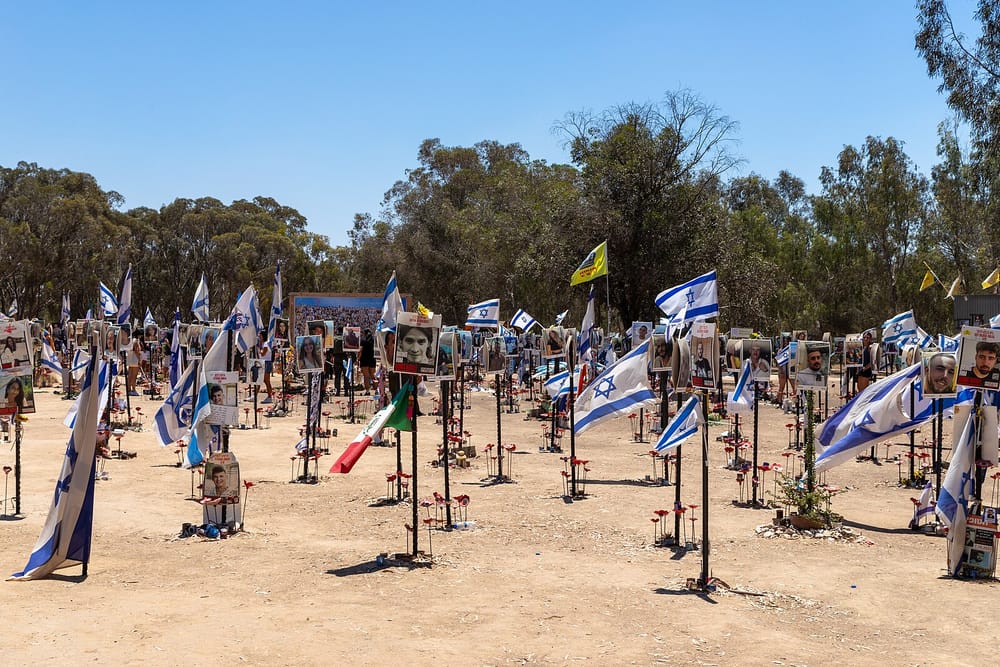
Now I am become Death, the destroyer of worlds.
So significant is this line in Christopher Nolan’s new blockbuster Oppenheimer that we hear it twice: first, during a sex scene between the titular character and his lover Jean Tatlock; and later, after the successful test of J Robert Oppenheimer’s invention, the atomic bomb. Although the quote’s historical accuracy is dubious, one thing is for certain: Oppenheimer knew that his technology had changed the world, and that the power of death would forever be in the hands of those who wield it.
Watching these scenes, I was immediately struck by the pertinence of Achille Mbembe’s theory of necropolitics in the post-nuclear world. To Mbembe, necropower is the ability to subjugate life to the power of death. This operates through access to weapons, which construct death-worlds, or “new and unique forms of social existence in which vast populations are subjected to conditions of life conferring upon them the status of living dead.” By uttering the now-infamous line from the Bhagavad Gita, Oppenheimer similarly acknowledged that, with the power of the atomic bomb, the United States had an unparalleled ability to destroy and to consign entire populations to the realm of the living dead.
Crucially, Mbembe’s death-worlds are not random, and neither were the ones created within the shadow of American nuclear power. Rather, necropower is inherently racialised. By coding non-white lives as less valuable than white ones, racism “regulate[s] the distribution of death,” in the necropolitical order.
Mbembe argues that necropower is at its strongest in the colonial context, where racialisation facilitates mass death and terror. In this way, the death-world is always othered and placed outside the centre of Western imperial power. The history of the nuclear bomb, as explored in Oppenheimer, and its exclusive use to destroy the lands and lives of non-white peoples, upholds this logic.
Even without the language of necropolitics, viewers of Oppenheimer immediately recognised the racism at play. Critics have questioned the value of recounting the creation of the atomic bomb without including the perspectives of non-white communities who faced its devastating consequences – namely, the indigenous tribes surrounding Los Alamos where it was created and tested, and the surviving residents of Hiroshima and Nagasaki. Other commentators have defended this directorial choice, noting that the limited perspective of the film underscores its real-life white supremacist history.
However, another set of viewers has taken this debate in an entirely different direction, arguing that Nolan’s omission of a different non-white perspective – the Jewish identity of J Robert Oppenheimer – renders the entire debate null and void.
The argument that Jews are not white is a common one, but it often lacks the historical and contextual nuance to be taken seriously. Many Jewish people are indeed not white; there are Jews all over the world, with a variety of racial identities. However, when this type of argument surfaces, Jewishness is generally used to create a claim to racialisation where one would not otherwise exist, almost always in reference to American and European Jews of Ashkenazi descent.
This argument is not only historically incorrect; it also reifies a racist hierarchy of violence that continues to oppress non-white people around the world, specifically Palestinians. And in the case of Oppenheimer, this danger could not be clearer.
A white story or a Jewish one?
Although only an ancillary plotline in Nolan’s film, six of the eight primary scientists of the Manhattan Project were, in fact, white Jews. J Robert Oppenheimer did not identify with his Judaism, however, purposefully hiding the significance of his first initial – J for his father’s name, Julius – and largely distancing himself from this identity to avoid the damaging effects of rampant antisemitism.
In a recent article for the Jewish Chronicle, David Baddiel claims that although Oppenheimer “liked to pretend he wasn’t Jewish,” his Jewish identity was “the secret driver of his work at Los Alamos.” The latest in Baddiel’s sloppy depictions of Jewish racialisation, his logic here contributes to the discourse that Oppenheimer is not a white story at all, but rather a Jewish one.
Yet by allowing Oppenheimer’s Jewishness to deflect from his role in perpetrating non-white death, we risk strengthening both antisemitism and the white supremacy at its core. Instead, by situating Oppenheimer’s white Jewish identity within its context, we can better dismantle the death-worlds that his weapon continues to create.
In the film, Nolan’s characters scarcely mention their Jewish identities and, when they do, it is almost exclusively while discussing the need for the Allies to develop an atomic weapon before the Nazis. In this way, we are led to think that the Jewish identities of these scientists contributed to their support for the Manhattan Project, and more importantly, justified their participation. In real life, there is little to no evidence for this argument, while there is increasing doubt among historians that Germany was ever the intended target of the atomic bomb.
Although Nolan certainly critiques the morality of the bomb writ large, the film upholds Jewish suffering as justification for a weapon of mass destruction. Modern commentators have continued this line of reasoning, positioning the development of the atomic bomb in a shady moral landscape – one where defeating the Nazis and saving Jewish lives outweighed other considerations, like the lives of Japanese civilians.
At the time, however, the Jewish scientific community was far from unified on this position. Nolan showed a portion of this division, focusing on Oppenheimer’s refusal to sign the Szilárd petition. Many of the most vocal dissenters from the Project were also white Jews, like Leo Szilárd himself and Joseph Rotblat, who left Los Alamos as a conscientious objector.
The actions of these Jewish scientists are overlooked in the modern debate on nuclear technology, but they serve an important lesson: there have always been objections within the Jewish community to the violence done in our name, especially when that violence serves racist and imperial ideologies. Beyond serving a dubious moral claim, the effort to characterise Oppenheimer and his Jewish colleagues as non-white is simply ahistorical. Charles W Mills’ landmark work, The Racial Contract, clearly articulates this problem.
For Mills, race is politically constructed, and the criteria for who counts as white at any given point in history is subject to change. Echoing other theories of race, such as Du Bois’ notion of the global colour line, Mills locates the emergence of white supremacy in the colonial period. He notes that for most of modern history, European and American Jews have been on the white side of the global colour line. The evidence for this argument comes primarily from the readily apparent power relation between white Jews and colonised peoples.
Nazism, Mills argues, revoked the whiteness of European Jews, creating the conditions within the German discursive landscape for the acceptability of Jewish death, and therefore utilising racialisation to exert necropower. Likewise, to Mbembe, the Nazi concentration camps represented a perfect death-world, and the revocation of whiteness played a key role in their operationalisation. Stating that Oppenheimer was non-white in his American context, however, and specifically in relation to both the Japanese and indigenous victims of his invention, is simply untrue.
Dismantling the Palestinian death-world
Perhaps even more worryingly, this type of rhetoric obscures the role of modern white Jews in necropolitics, particularly in the racist death-world of occupied Palestine. Mbembe writes that the most “accomplished form of necropower is the contemporary colonial occupation of Palestine.” And critically, the power of the Israeli state to annihilate is massively supported through the government’s nuclear capabilities, which can of course be traced back to the Manhattan Project.
After the destruction of Hiroshima and Nagasaki, Dr. Chaim Weizmann, who would become Israel’s first president, approached the Manhattan Project scientists, including Oppenheimer, to gain support for a nuclear weapons program for the Zionist movement in Palestine. Although Weizmann eventually changed his stance on nuclear technology, his connections to the Manhattan Project played a pivotal role in Israel’s journey to becoming a nuclear state.
In 1951, Oppenheimer met with David Ben-Gurion, Israel’s prime minister, to “advise him regarding the best way to develop Israel’s plutonium reserves”; Ben-Gurion later credited Oppenheimer with giving him the “drive” to plan the state’s nuclear weapons programme. Oppenheimer officially visited Israel in 1958 and became a member of the board of governors for the Weizmann Institute of Science in the city of Rehovot. By propping up Israel’s military power, nuclear technology continues to play a role in the construction of a death-world – both for the Palestinians and for non-white Jews who are persecuted by the racist Zionist order.
Of course, the atomic bomb is not a Jewish conspiracy, and those who disproportionately blame Jews for the evils of white supremacy are simply rehashing antisemitic tropes. However, for those of us who identify as white Jews, we are doing ourselves and our comrades a disservice when we refuse to tackle our nuanced relationship to white supremacy head on – and Oppenheimer is one part of this history.
By obfuscating the role of white Jews in the invention and dispersal of nuclear technology, we limit our ability to honour the memories of its victims and fight for populations still haunted by the spectre of nuclear power. To dismantle the Palestinian death-world, we must resolutely condemn the one created in Los Alamos. We must once again become the destroyer of worlds, but this time through our dedication to Life.▼
Kendall Gardner is a doctoral candidate in political theory at the University of Oxford.
Author

Kendall Gardner is an editor at Vashti and a doctoral candidate in political theory at the University of Oxford.
Sign up for The Pickle and New, From Vashti.
Stay up to date with Vashti.



